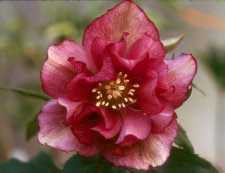
Discriminating Gardener and Collector

|
Sunshine Farm and Gardens
Rare and Exceptional Plants for the
Discriminating Gardener and Collector |
Home : Focus on Hellebores : About Double Hellebores
 I'm completely enthralled with double Hellebores. The term
double is a bit misleading, though. It would normally refer
to a plant whose sexual parts have become petaloid. A good
example of a true double would be
Sanguinaria canadensis 'Multiplex'
This is a plant with no sexual organs and can only be propagated
asexually, i.e., by division.
I'm completely enthralled with double Hellebores. The term
double is a bit misleading, though. It would normally refer
to a plant whose sexual parts have become petaloid. A good
example of a true double would be
Sanguinaria canadensis 'Multiplex'
This is a plant with no sexual organs and can only be propagated
asexually, i.e., by division.
In what we refer to as 'Anemone Centered' Hellebores, these nectaries have started to become petaloid and have taken on the color of the sepals.
Our Hellebore Galleries
features our latest doubles, semi-doubles, and anemone-flowered Hellebores.
|
Copyright © Barry Glick 1996-2025. All Rights Reserved.
Barry Glick, Sunshine Farm and Gardens
696 Glicks Rd, Renick, WV 24966, USA
Phone: (304) 497-2208
E-mail: barry@sunfarm.com
Last modified February 24, 2009
URL: https://www.sunfarm.com/plantlist/hellebores/hellebore_doubles.phtml